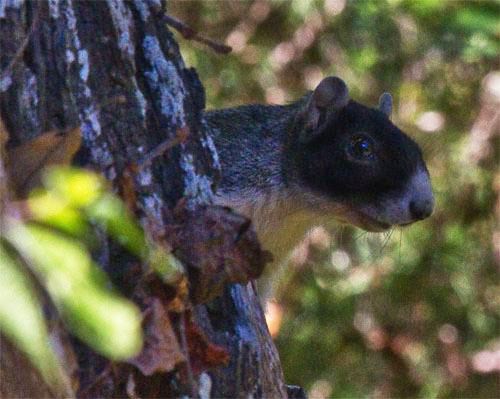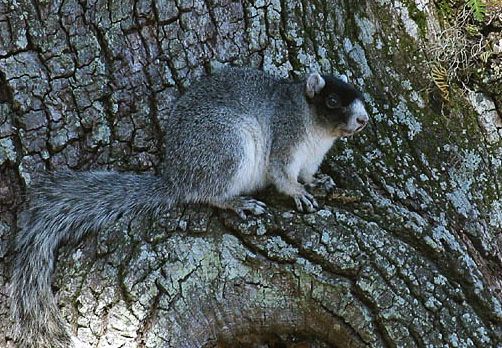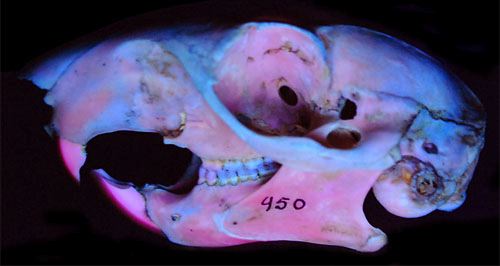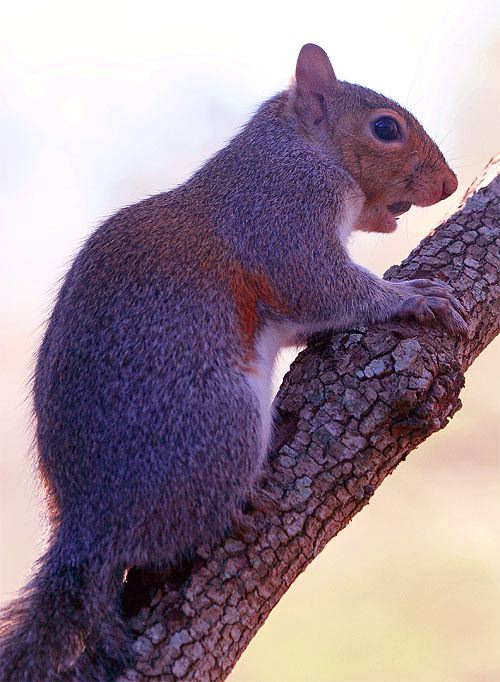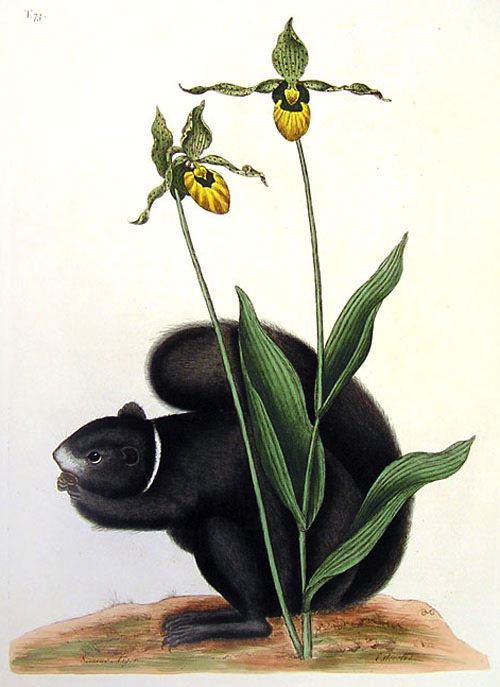|
|
|||
|
(Back to Preceding Week; on to Next Week) |
|
SIGN UP FOR TWO OR MORE EXPEDITIONS AND GET $100 OFF ON EACH !
Join fellow birders & educators as citizen scientists on 2011 Operation RubyThroat expeditions to observe, capture & band hummingbirds in Belize, Guatemala & Costa Rica. No experience necessary! Alumni of selected Holbrook trips receive an additional $150 discount on one hummingird excursion. (Click on logo below for more info.) |
|
NEW YARD MAMMAL FOR HILTON POND: On the afternoon of 23 October we had just returned from an overnight trip to Newberry College, our undergraduate alma mater, where we spoke to students and faculty about career paths in the natural sciences. When we got to Hilton Pond Center we walked down the long "dogtrot" hall of the old farmhouse and sat down at our computer station where a big window faces west and looks out over the pond itself.
All maps, text & photos © Hilton Pond Center Having lived and studied at Hilton Pond Center for almost three decades, it's getting harder and harder to find new animals on the 11-acre property--especially among vertebrates. We haven't banded a new bird species since a Cooper's Hawk (#124) in November 2004, or added a new bird sighting since a Solitary Sandpiper (#169) in August 2008. New mammals are even harder to come by at the Center, with only 28 species observed since 1982--the latest being a mangy Red Fox in October 2006 and a tree-toppling American Beaver in April 2008. We fully expected the next mammalian addition to our "yard list" would be a Coyote, if only because we hear them singing almost nightly from neighboring farms. Thus, we were pleasantly shocked to observe this apparently healthy Fox Squirrel out our back window, a species we've seen in the South Carolina Lowcountry but as far as we know is undocumented from northern York County where the Center sits.
The Fox Squirrel was first described in 1758 by Swedish taxonomist Carl Linnaeus from a South Carolina specimen that was black (at right above, as rendered by John James Audubon)--hence its scientific name, Sciurus niger. There are ten recognized North American subspecies, with the Southern Fox Squirrel, S. n. niger, the one found in the Carolinas and Georgia.
All maps, text & photos © Hilton Pond Center As Audubon noted, hair color varies somewhat among Fox Squirrels. Within the southern subspecies, most individuals are dorsally silver or gray with a lighter underside (as above) but are sometimes black; despite the base color, a dark head with contrasting white nose is diagnostic--a field mark that does not occur in Eastern Gray Squirrels, Sciurus carolinensis (below).
All maps, text & photos © Hilton Pond Center Fox Squirrels have shorter ears than Eastern Gray Squirrels (lactating Gray Squirrel female, above), hence an alternate name of "Stump-eared Squirrel." The Fox Squirrel's mask-like facial pattern leads to even more nicknames, including "Raccoon Squirrel" and "Monkey-faced Squirrel." 
All maps, text & photos © Hilton Pond Center Fox Squirrels are the Western Hemisphere's largest tree squirrels at a maximum of 2.6 pounds and total length of 27.5"; about half this length is tail. In comparison, a big Eastern Gray Squirrel will be about 22" long and tip the scales at 1.2 pounds. Fox Squirrel bucks and does are monomorphic--alike in size and appearance--except a breeding male may have a large scrotum and lactating females often have visible nipples. Despite the size difference in Fox and Gray Squirrels, hunters and nature lovers alike still sometimes mistake the two species--especially when a Fox Squirrel is young. Unfortunately, the definitive way to differentiate the two species requires a dead animal for examination. First, each side of a Gray Squirrel's upper jaw has three molars and a premolar and SOMETIMES an anterior-most extra peg-like premolar--a structure always absent in Fox Squirrel skulls with four molariform teeth per quadrant, as above.
All maps, text & photos © Hilton Pond Center Second, due to sequestering of porphyrin Fox Squirrels are unique among mammals in that their teeth and bones fluoresce pink under UV light (as shown in the photo above by Steve Sullivan, curator of urban ecology at Chicago Academy of Sciences and its Peggy Notebaert Nature Museum).
All maps, text & photos © Hilton Pond Center Fox Squirrels are adequate climbers but usually spend much more time on the ground foraging than highly arboreal and more agile Eastern Gray Squirrels (above). In the Carolina Lowcountry Fox Squirrels frequent Longleaf Pine flatwoods; prime Piedmont habitat includes open mixed woods populated with Loblolly and Shortleaf Pine and nut-bearing hardwoods such as hickory, oak, and walnut. Like most tree squirrels, Fox Squirrels collect and cache food, often burying seeds where they sprout and help propagate the mother tree. Some Fox Squirrel populations become established in what we call "artificial oak-pine savannas" (AKA "golf courses"); others are closely tied to residential areas where corn and sunflower seeds at backyard bird feeders provide an abundant source of food. Fox Squirrels are primarily herbivores, dining especially on hardwood nuts and pine seeds with seasonal supplements of fungi, tree buds, willow catkins, and the fruit of maples, dogwoods, grapes, and persimmons; insects and bird eggs are taken upon occasion.
All maps, text & photos © Hilton Pond Center Clemson University surveys of South Carolina's Southern Fox Squirrels found scattered populations in the Coastal Plain, even fewer in the Piedmont, and essentially none in the northwestern counties of the state's Mountain Province; Georgia shows similar distribution, while in North Carolina--despite historical statewide occurrence--Fox Squirrels now are restricted almost exclusively to the southeastern Coastal Plain. (NOTE: There's always a possibility Fox Squirrels have wandered beyond the areas described. If you're aware of modern-day Fox Squirrel sightings in South Carolina and adjoining North Carolina but OUTSIDE the area marked with green on the map above, please let us know with date and location at INFO.)
All maps, text & photos © Hilton Pond Center Older female Fox Squirrels (lactating female above) breed twice annually in very late spring and again in midwinter, producing one to six young per litter. (Young females probably mate only once per year, in December or early January.) Recently weaned pups become independent at about three months and reach sexual maturity within a year. Most are taken at a young age by predators or succumb to disease with the record age for a captive specimen at close to 20 years. While Fox Squirrels are hunted legally throughout their range, they can't be harvested on many of South Carolina's state-run wildlife management areas. These days primary predators are probably feral cats, hawks, and crepuscular owls, although exclusively diurnal behavior of Fox Squirrels makes them less susceptible to the latter. Fox Squirrel populations have declined significantly throughout their range during the past century primarily from loss of suitable habitat. Since Fox Squirrels build leaf nests and occupy hollow trees, the scarcity of suitable cavities may increase winter mortality of both newborns and adults. Death by automobile hasn't helped, either, and pressure from plentiful and more adaptable Eastern Gray Squirrels that require smaller home ranges may have had impact.
All maps, text & photos © Hilton Pond Center Despite all these threats, in recent years Fox Squirrels (including black ones like the one above painted with Yellow Lady's Slipper by Mark Catesby) seem to be holding their own--albeit at far lower numbers than once occurred in the Carolinas--and our latest sighting in northern York County is evidence the species may even be expanding its range. Thus, we were understandably excited this week to see and photograph our first on-site Southern Fox Squirrel, and we're keeping our camera close at hand in case this individual makes another appearance. After all, it's not every day--or year--we can say we've added a new mammal to Hilton Pond Center's "yard list." All maps, text & photos © Hilton Pond Center If you have a Twitter account and liked this page, you can Follow us on Twitter: @hiltonpond
|


 Preparing to check our inevitable backlog of e-mails, we glanced out the window for the rear-end view of a squirrel foraging on acorns beneath a big Southern Red Oak. It's not unusual to see Eastern Gray Squirrels in such a situation, but we did a double-take when we saw this particular squirrel's bushy tail; our first impression was it was noticeably longer and fuller than that of a Gray Squirrel, so we looked more closely. Eventually the creature turned sideways and we did a triple-take. This squirrel's body and tail were gray but it had a black head and a white nose, so there was no doubt it was a Southern Fox Squirrel--a new mammal species for the Hilton Pond checklist! We grabbed our Canon camera with 100-400mm zoom lens but watched helplessly as the Fox Squirrel made a beeline for the oak tree 15 yards away and disappeared. Luckily, a few minutes later our quarry peered out from behind the trunk just long enough for us to make one exposure (below); that grainy photo was all we needed to confirm our initial impression that indeed this was our first-ever Fox Squirrel for Hilton Pond Center.
Preparing to check our inevitable backlog of e-mails, we glanced out the window for the rear-end view of a squirrel foraging on acorns beneath a big Southern Red Oak. It's not unusual to see Eastern Gray Squirrels in such a situation, but we did a double-take when we saw this particular squirrel's bushy tail; our first impression was it was noticeably longer and fuller than that of a Gray Squirrel, so we looked more closely. Eventually the creature turned sideways and we did a triple-take. This squirrel's body and tail were gray but it had a black head and a white nose, so there was no doubt it was a Southern Fox Squirrel--a new mammal species for the Hilton Pond checklist! We grabbed our Canon camera with 100-400mm zoom lens but watched helplessly as the Fox Squirrel made a beeline for the oak tree 15 yards away and disappeared. Luckily, a few minutes later our quarry peered out from behind the trunk just long enough for us to make one exposure (below); that grainy photo was all we needed to confirm our initial impression that indeed this was our first-ever Fox Squirrel for Hilton Pond Center.